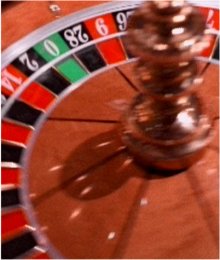 Stanford University researchers have found that when men are exposed to erotic images an area of the brain associated with the anticipation of reward is stimulated, causing the men to take bigger financial risks than they otherwise would.
Stanford University researchers have found that when men are exposed to erotic images an area of the brain associated with the anticipation of reward is stimulated, causing the men to take bigger financial risks than they otherwise would. The study, published in NeuroReport, used functional magnetic resonance imaging (fMRI) to track changes in participants' brains as they viewed photographs of positive, negative or neutral subjects and then had to quickly make a decision to choose one of two levels of financial risk in a required gamble.
Study author Brian Knutson had previously shown that fMRI could be used to predict whether people were about to take a financial risk. When they were, an area of the brain called the nucleus accumbens showed increased activation. When they were about to choose to avoid the risk, a different area called the insula showed increased activation.
In the new study, Knutson and his colleagues studied heterosexual male undergraduate college students. The images the men viewed were intended to stimulate an emotional response. Erotic images were used to elicit a positive response, snakes and spiders to prompt a negative response, and office supplies to trigger a neutral response.
After viewing each image, the participants immediately had to decide whether to take the high-risk option of gambling a dollar or the low-risk option of gambling a dime. Regardless of their choice, they had a 50-50 chance of winning or losing. Knutson gave each man $10 to gamble with prior to entering the MRI scanner. "We wanted them to care," Knutson said. Depending on the men's gambles and the random outcomes, they won or lost. "We took that money back if they lost it," he explained.
"What we saw is that when they viewed the erotic pictures, the activation in their nucleus accumbens increased compared to the other stimuli, and also that they had increased activation in that region before choosing the high-risk gamble," Knutson said. The researchers then applied a statistical analysis to determine whether the activation in the nucleus accumbens accounted for some of the behavioral effect. "The answer was yes, at least in the case of the positive stimuli," Knutson said. "After people had seen those erotic pictures, they tended to pick the high-risk gamble more often."
The findings have implications for what might make emotional appeals effective or ineffective in applications ranging from advertising to finance to politics and, perhaps not surprisingly, gambling. "If you go to the casinos, people are wearing skimpy costumes, they're giving you free alcohol, there are bells and lights and things like that, which don't necessarily seem related to the odds of the gambling," Knutson said. "But these are cues that might activate brain regions that encourage risk-taking and therefore get people to gamble more."
Related:
Subliminal Erotic Images Get Our Brains All Hot And Bothered
Male And Female Brains React Differently To Sexy Stimuli
Source: Stanford University





